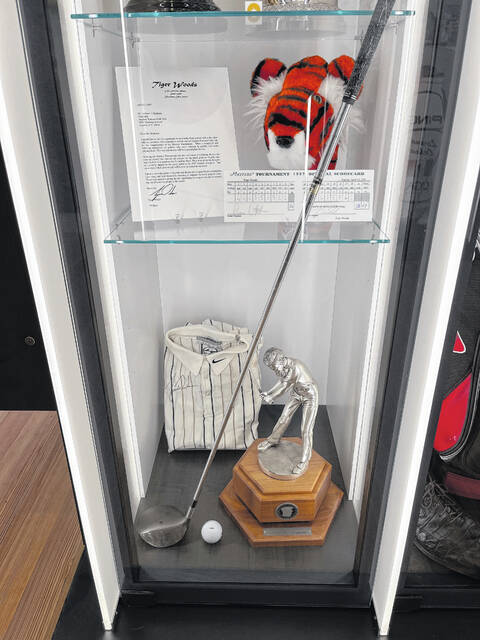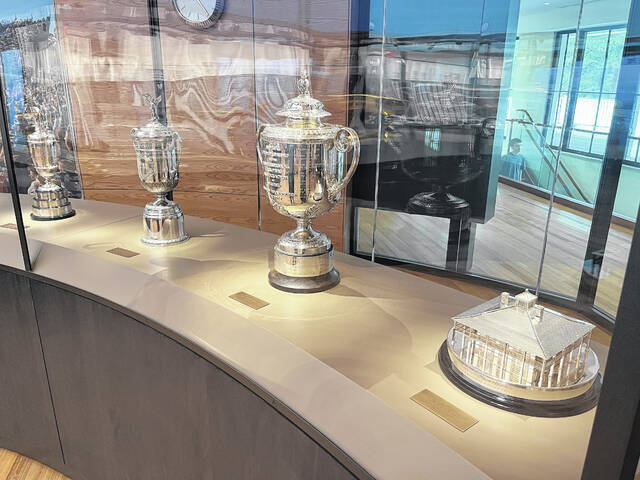
Tiger Woods’ locker at the World Golf Hall of Fame in Pinehurst includes, clockwise from top left: a letter sent by Woods to Augusta National Golf Club after his 1997 Masters win; a headcover; his final round scorecard from the 1997 Masters; the Haskins Award earned as the nation’s top collegiate golfer; a club and ball from his career; and the shirt he wore during the third round of his 2000 U.S. Open win.
Chris Stiles | The Robesonian
PINEHURST — The World Golf Hall of Fame ran advertising about a decade ago that would end with the tag line, often narrated in Gary Player’s distinctive South African accent, “if you love golf, you’ve got to go.”
For those of us who love golf here in the Sandhills, that act of going is now much more convenient than it used to be.
The World Golf Hall of Fame reopened last month as part of the USGA Golf House at the Pinehurst Resort. Ahead of next week’s 124th U.S. Open at Pinehurst No. 2, I took some time Thursday to explore and learn more about the history of the game and those who have played it the best.
The Hall opened in Pinehurst in 1974, but in 1998 moved to St. Augustine, Florida. With the confluence of events of the USGA opening a second headquarters, the USGA regaining management of the Hall and Pinehurst hosting its fourth Open, the timing was perfect for the Hall to return to its original home, appropriately now relocated at “the Home of American Golf.”
The new home to the Hall is a building located only about 1,000 feet from the first tee of Pinehurst No. 2, the resort’s signature course and one of the most renowned in all of golf. The Hall will be open to the public during the U.S. Open — though it might be a little more crowded next week than it was during my visit Thursday — and will remain open afterward. Admission is free until July 1, then will remain affordable at $10.
The two-story facility features the World Golf Hall of Fame on the second floor, but the USGA Experience on the ground floor also has plenty to offer the curious golf fan. This includes an exhibit about the science of golf, from clubs and balls to grass and irrigation, and the Championships Gallery, which includes replica trophies of USGA championships and information on how they are run.
It also includes “Golftown, U.S.A.: Pinehurst’s History in 50 Moments,” an exhibit on the storied history of golf in the Pinehurst area from the resort’s origins, to the dramatic championships contested, to visits from celebrities and presidents and everything in between. That exhibit includes the shirt, vest, cap and glove worn by Payne Stewart, plus the putter and ball used on the winning putt, from his iconic 1999 U.S. Open victory at Pinehurst No. 2.
But the highlight is the Hall of Fame, where the game’s greats are enshrined in perpetuity. Some 170 “lockers” make up the room, with each focused on one inductee and containing artifacts from their career, handpicked by the member or, if deceased, their family.
Many include a golf ball used for a special shot in the individual’s career or the club with which they struck it, or trophies won in their glorious past, or scorecards recounting those triumphs, or apparel worn. But there’s also a variety of artifacts with greater meaning.
You can read the letter Tiger Woods wrote to Augusta National after his dominant and historic win in the 1997 Masters. You can see the Arnold Palmer-branded magic marker that The King used to sign countless autographs for fans (it’s widely believed no one in golf has signed more). You can see the drawn-by-hand yardage book of Ernie Els from one of his Open Championship victories.
You can also see even more novel items, like the triple-jointed club disabled golfer Dennis Walters used to hit trick shots in his act, or a replica of the custom club astronaut Alan Shephard used to hit a golf ball on the moon. You can see Bibles opened to the favorite verse of inductees, while others have their favorite Stephen King novel or Andy Griffith Show DVD on display, showcasing the off-course personalities of some of these legends.
Perhaps in another decade or two the locker of a new Hall of Famer will include the ball that fell in the hole on winning putt next week, or the sweat-stained hat that player wore as they won our national championship.
Two presidents, Dwight D. Eisenhower and George H.W. Bush, are also in the Hall for their contributions to the game, as are celebrity golfers like Bing Crosby, Bob Hope and Dinah Shore. Media members, executives, course designers and others are immortalized for their own impact.
Lockers are already in place for new inductees Padraig Harrington, Sandra Palmer, Johnny Farrell, Beverly Hanson, Tom Weiskopf, as well as the 13 LPGA founders that will be enshrined together; their official induction will be Monday as part of the U.S. Open’s pre-tournament festivities.
At the center of the room showcasing all this greatness and legacy sits a large glass case containing replicas of the trophies of every men’s and women’s major championship, as well as the FedExCup and CME Globe year-long points titles for the PGA and LPGA tours. Standing with Jonathan Bym, the former Robesonian sports editor with whom I toured the Hall, we discussed the irony of the trophy most people say they want the most also being the smallest: the Masters trophy, which in silver mimics the Augusta National clubhouse.
If you’ve read my columns in this publication over the years you’re probably well aware by now how much of a golf nerd I am. I also more broadly enjoy history and learning. A couple of hours in the USGA Experience and World Golf Hall of Fame certainly stoked the fire on all these passions, and was a great way to look ahead to next week’s U.S. Open (as was the money I spent in the merchandise area for the tournament, which is now open to the public, but that’s another story).
And while the marketing used for the World Golf Hall of Fame ultimately moved on from that old slogan, it still remains true — and I know most of you reading this are an easy drive away from the newly-reopened shrine to the game.
So I’m sincere when I bring back that tagline to say: if you love golf, you’ve got to go.
Sports editor Chris Stiles can be reached at 910-816-1977 or by email at [email protected]. You can follow him on X/Twitter at @StilesOnSports.










